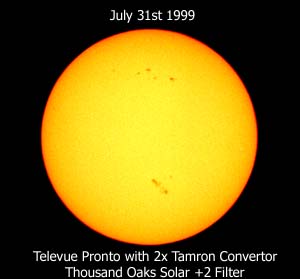Royal Astronomical Society of Canada - Join Now!Safe Solar Viewing |
Victoria Centre is part of the national Royal Astronomical Society of Canada, which is dedicated to bringing information about astronomy to the general public. | |
|
|
|
|
|
|
A PROPER FILTER ON THE FRONT OF YOUR TELESCOPE OR BINOCULARS or by PROJECTING THE SUN'S IMAGE ONTO A VIEWING SURFACE  Solar Filter Basics All solar filters must reduce sunlight intensity before it enters the optical path. Never use anything but an approved, fitted solar filter. Always check the filter for damage before you use it. Always cover the finder scope. Attach the filter securely to your telescope or binoculars. A proper filter will block nearly all the visible sunlight and the invisible infrared and ultraviolet light. This protects your eyes and your instrument. Aim the telescope by watching the telescope's shadow; the sun is in view when the telescope's shadow is circular. Kinds of Solar Filters Hydrogen-Alpha The most expensive filter. A 'pre-filter' fits on the top end of the telescope. This blocks infrared and ultraviolet light and makes the telescope safe to use. The filter itself fits between the telescope and the eyepiece. This filter removes all light except for a single wavelength - the wavelength emitted by hydrogen atoms.You see granulation, filaments, flares and prominences on a ruby sun. Glass Solar Filter Multiple layers of nickel-chromium stainless steel coat the optically flat glass on both sides.Only 1/1000 of 1% of the sun's light passes through the filter. This filter is more expensive than a mylar filter. You see an orange sun and detailed sun spots. Solar Safety Film An annealed, high-strength polymer metallized on both sides of the film. This film is very durable. You see a white sun, detailed sun spots and white filaments (faculae). Astronomical Mylar Filter DO NOT use anything but astronomical grade mylar. Doesn't cost as much as the coated glass filters. 'Eclipse' glasses are mylar. Metal coats a special heavy, strong mylar and blocks infrared and ultraviolet light. A frame that fits over the front end of a telescope or binoculars holds two coated mylar layers. You see a blue sun and detailed sun spots. No. 14 Welding Filter DO NOT use at an eyepiece!!! DO NOT use a No. 12 filter to
look at the sun - it lets too much light through. The Alternative Method for Viewing the Sun - Projection You don't need a filter. Use a small refractor - the aperture should be 60mm in diameter or less. Use an eyepiece that magnifies about 30x. The eyepiece should not have cemented elements. Project the image onto a white card that's shielded from the glare of the sun and focus. The image is large and shows lots of sunspot detail.
|
|